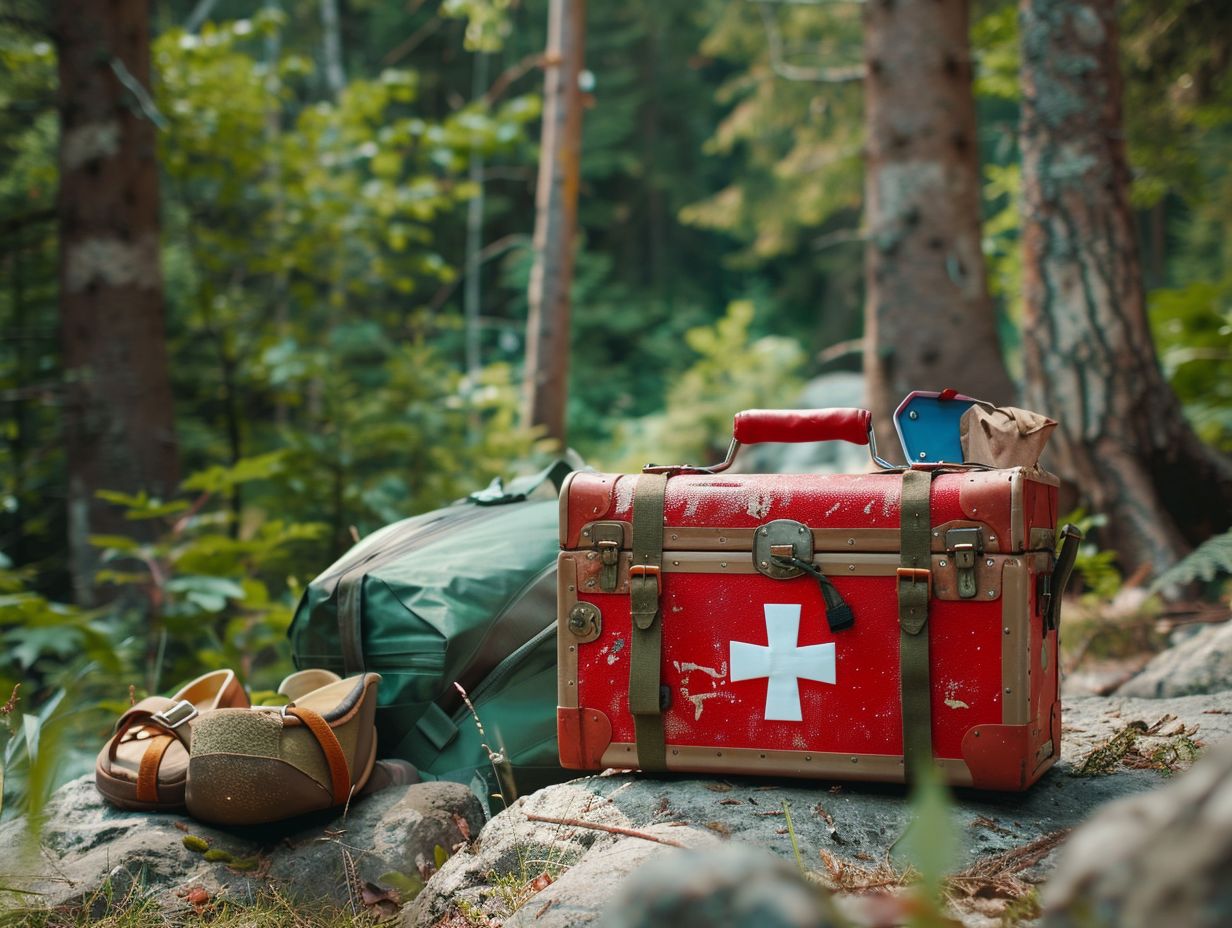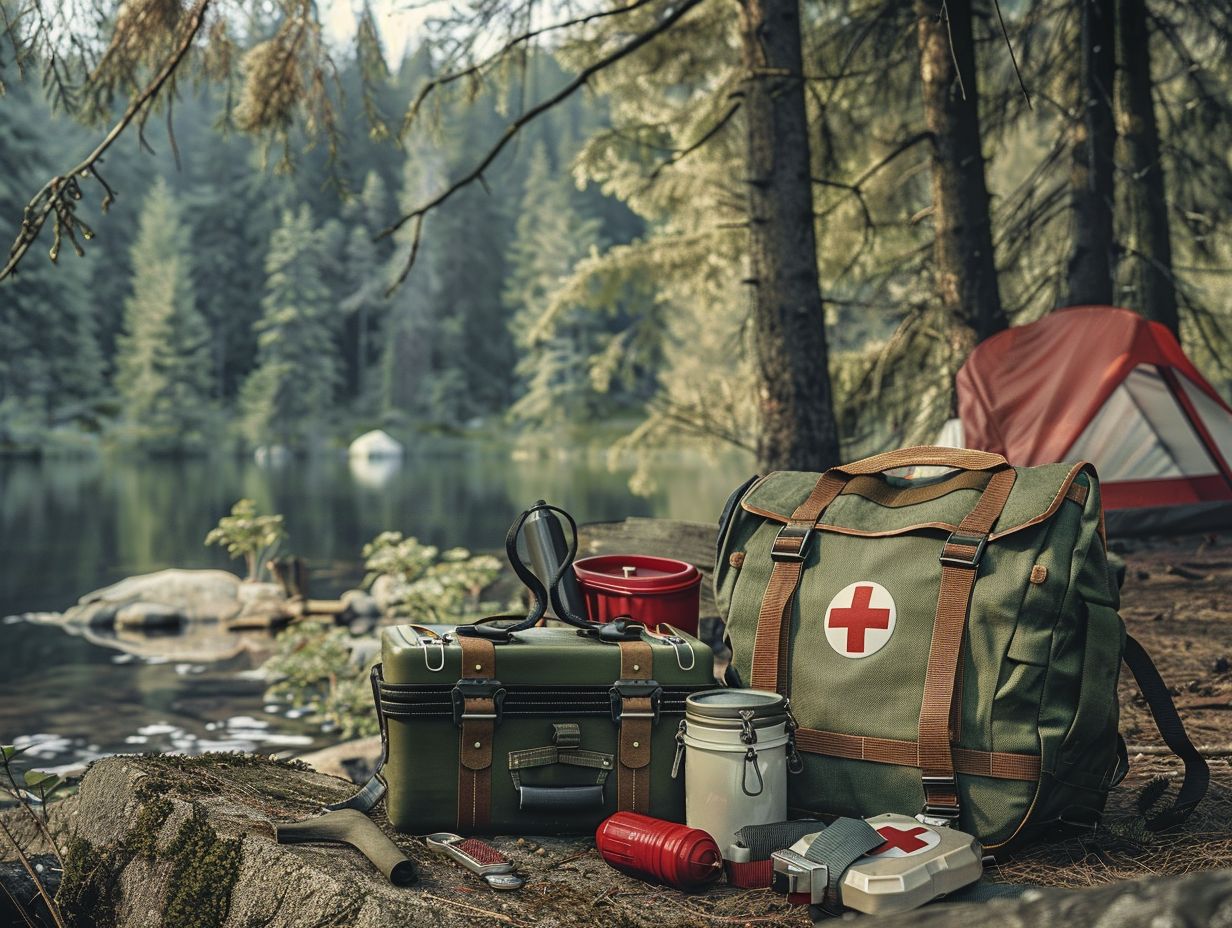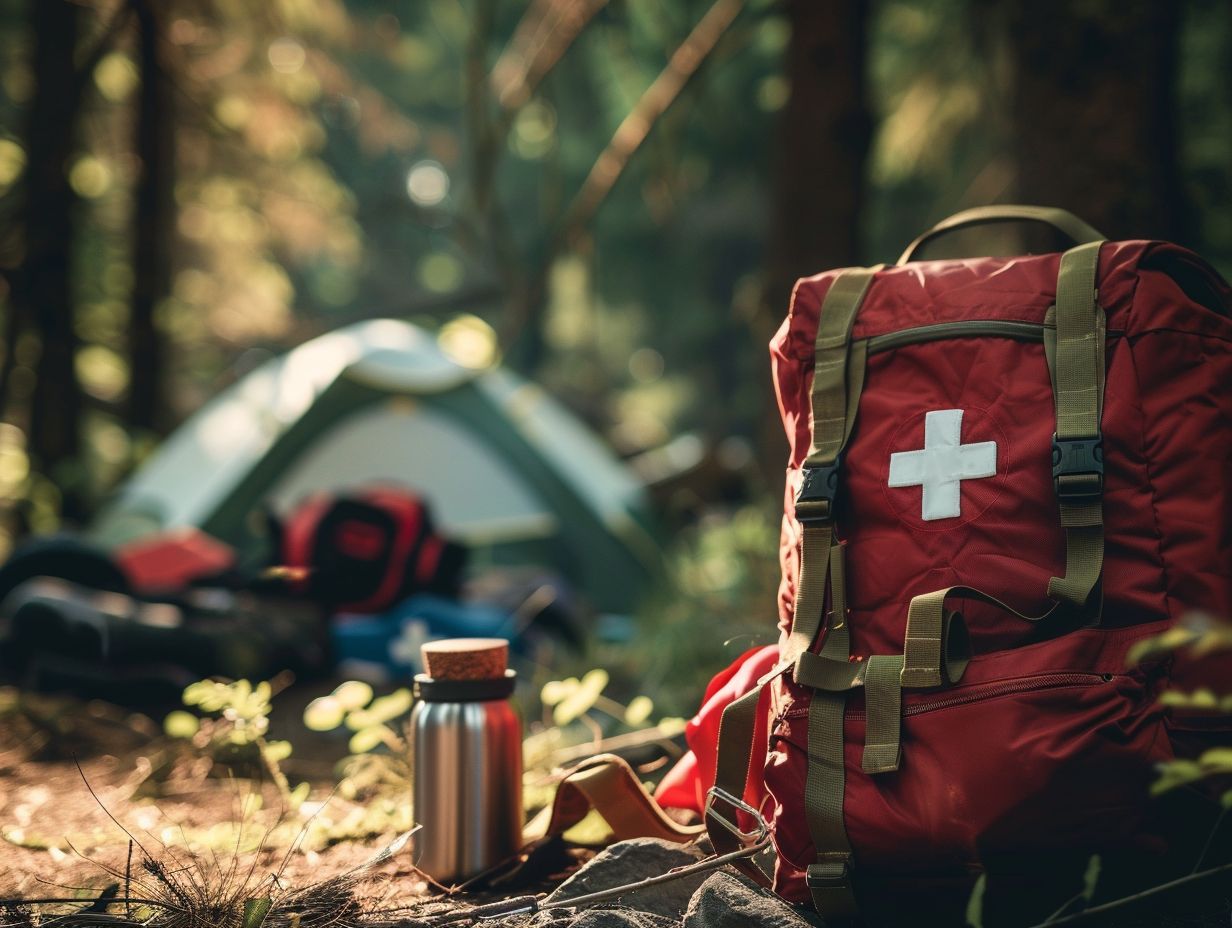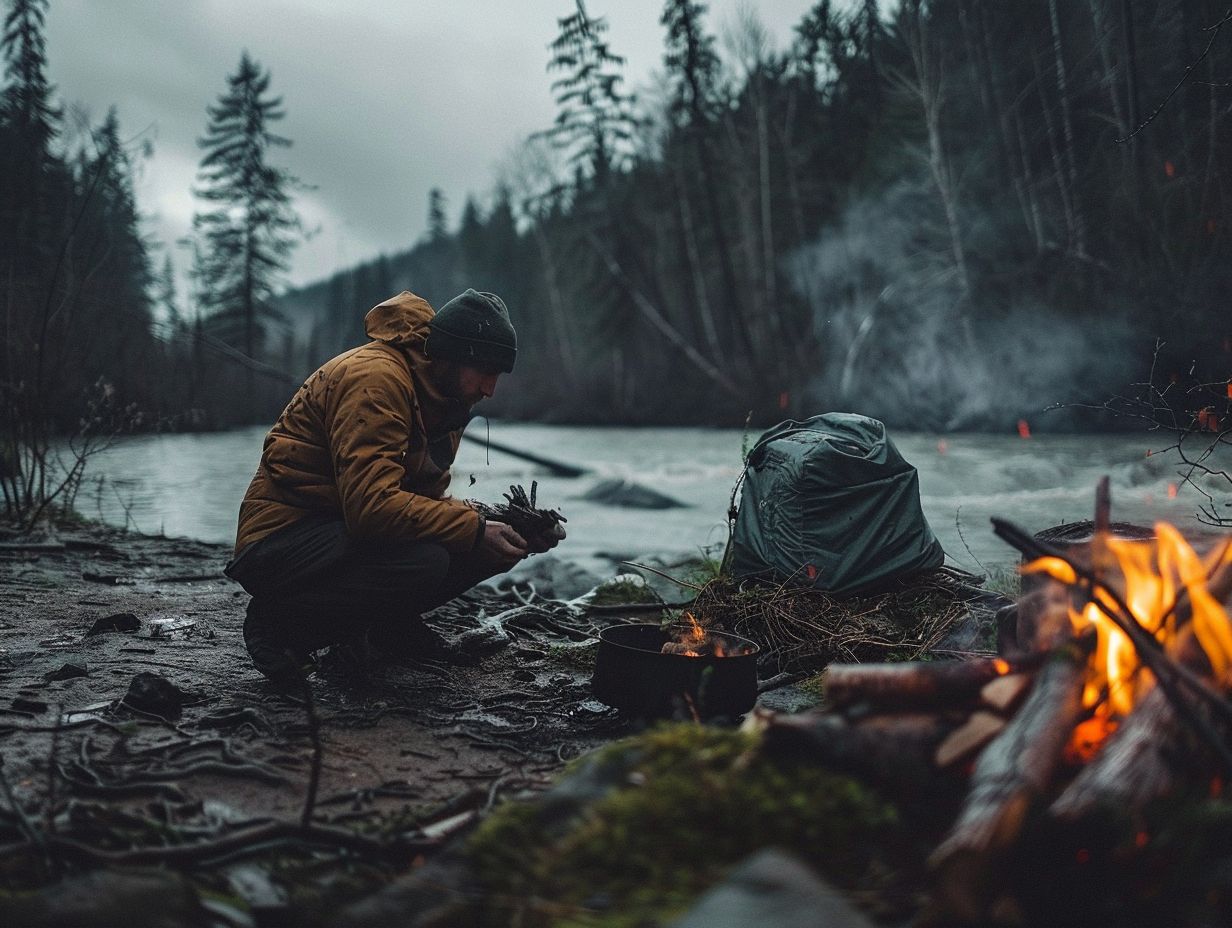When it comes to camping, being prepared for potential injuries and emergencies is crucial. You need to know the basics of first aid and ensure you have a well-equipped first aid kit with you. As a camper, it is essential to possess several key skills in first aid.
In this guide, we will explore the essential first aid tips that you should know. This includes how to treat common injuries, manage allergic reactions, and be ready for emergency situations while in the great outdoors. By staying informed and prepared, you can ensure your safety on your next camping adventure.
Key Takeaways:

- Know the basics of first aid to be prepared for emergencies while camping.
- Pack a well-stocked first aid kit to treat common injuries and accidents in the wilderness.
- Be aware of potential dangers such as allergic reactions, poisonous plants, and insect bites while camping and know how to handle them.
1. Know the Basics of First Aid
Understanding the fundamentals of first aid is crucial for outdoor enthusiasts, especially when faced with emergencies in the wilderness.
Equipping yourself with basic first aid knowledge can truly make a difference in critical situations.
For example, knowing how to perform CPR can be life-saving when someone is in cardiac arrest. Similarly, understanding wound care techniques can prevent infections and promote faster healing.
Being able to assess injuries accurately allows for prompt and appropriate treatment, reducing the risk of complications. Quick and effective responses in emergency scenarios can be the difference between life and death, emphasising the importance of being prepared with basic first aid skills.
2. Pack a First Aid Kit
Carrying a well-equipped first aid kit is essential for any outdoor adventure to ensure you have the necessary supplies for medical care during emergencies.
When putting together a portable first aid kit, be sure to include antiseptics such as alcohol wipes or hydrogen peroxide for cleaning wounds, various sizes of plasters for dressing cuts, sterile gauze pads, and adhesive tape for secure wound coverage.
It is also crucial to have common medications like painkillers, antihistamines, and antidiarrhoeals, as well as tools like scissors, tweezers, and gloves for wound care.
To maintain the effectiveness of your first aid kit, regularly check the expiry dates of items and restock supplies after every use or at least annually.
3. Be Prepared for Common Injuries
Being prepared to handle common outdoor injuries is crucial for ensuring the safety of all adventurers during camping trips or wilderness explorations. In outdoor settings, adventurers may encounter a variety of injuries, including cuts, sprains, insect bites, and burns.
Cuts can occur while hiking or setting up camp, and it’s essential to clean the wound thoroughly with antiseptic wipes and dress it with a sterile bandage. Sprains, often resulting from twisting an ankle on uneven terrain, should be managed with the R.I.C.E. method: rest, ice, compression, and elevation.
Insect bites can cause itching and discomfort, so applying an anti-itch cream or taking antihistamines may offer relief. Burns, whether from campfires or cooking, should be cooled with cold water and covered with a clean cloth to protect the affected area.
4. Know How to Handle Allergic Reactions
Understanding how to manage allergic reactions, especially in remote areas, is crucial for providing timely care and preventing severe complications for outdoor enthusiasts. In such situations, quick access to antiseptics like benzoyl peroxide or other medications like antihistamines can be life-saving.
It is important to recognise the signs of an allergic reaction, such as skin rashes, swelling, or difficulty breathing, and take prompt action. If the symptoms persist or worsen, seeking professional medical help is paramount. Prompt treatment can prevent the allergic reaction from escalating into a serious medical emergency, ensuring the safety and well-being of individuals in outdoor settings.
5. Be Aware of Poisonous Plants and Insects
Having knowledge about poisonous plants and insects is essential for you to avoid potential hazards and minimise the risks of encounters with toxic flora and fauna in the wilderness.
Common poisonous plants such as poison ivy, poison oak, and hemlock can cause skin irritation, rashes, and even severe allergic reactions upon contact.
Insects like black widow spiders and scorpions can deliver venomous bites or stings that may lead to pain, swelling, and in extreme cases, systemic effects.
If you are exposed to these harmful organisms, it is crucial for you to promptly cleanse the affected area and seek medical attention if symptoms persist or worsen.
To prevent such encounters, make sure to wear protective clothing, use insect repellent, and stay on designated paths while exploring nature.
6. Know How to Treat Burns and Sunburns
Equipping yourself with the knowledge of how to treat burns and sunburns is essential for providing immediate relief and preventing further complications while engaging in outdoor activities.
For minor burns, such as those from contact with hot surfaces, you can typically manage them at home by running cool water over the affected area for several minutes. This can help reduce pain and swelling.
However, for more severe burns that result in blisters or cover a large area of the body, it is crucial to seek medical attention. This is important to prevent infection and ensure proper healing.
Regarding sunburns, applying aloe vera or an over-the-counter hydrocortisone cream can help soothe the skin and alleviate redness. It is imperative to avoid additional sun exposure and maintain adequate hydration to promote recovery from sunburn.
7. Be Prepared for Blisters and Foot Injuries

Anticipating and preparing for blisters and foot injuries is crucial for maintaining mobility and comfort during your outdoor adventures, particularly hiking or camping trips.
Wearing ill-fitting shoes or socks that rub against your skin is a common culprit for blisters, which can be quite painful and restrict your movement. Blisters form due to friction between your skin and footwear, causing a separation and build-up of fluid in the skin layers.
To prevent blisters, it is essential that you wear properly fitting footwear and moisture-wicking socks. You should also consider using moleskin or blister pads as a protective measure.
Along with blister prevention, taking care of your feet through regular inspections, ensuring they are clean and dry, and using foot creams can help maintain overall foot health during your outdoor excursions.
8. Know How to Identify and Treat Heat Exhaustion and Heat Stroke
Recognising the signs of heat-related illnesses like heat exhaustion and heat stroke is critical for timely intervention and preventing potentially life-threatening consequences during outdoor activities. Common symptoms of heat exhaustion include heavy sweating, rapid pulse, weakness, dizziness, nausea, and headache.
In more severe instances, heat exhaustion can progress to heat stroke, which is characterised by a high body temperature, confusion, hot and dry skin, and even loss of consciousness. To prevent these conditions, maintaining proper hydration is essential. It is important to drink an adequate amount of water and electrolyte-rich fluids and take breaks in shaded or cool areas.
If an individual exhibits indications of heat-related illness, it is advised to relocate them to a cooler environment, remove excess clothing, and apply cool damp cloths to their skin while promptly seeking medical assistance.
9. Be Prepared for Hypothermia and Frostbite
Preparation for hypothermia and frostbite is essential in cold weather conditions to safeguard against these potentially dangerous cold-related health issues during your outdoor excursions. Understanding the risk factors for hypothermia and frostbite is crucial for you to take proactive measures.
Symptoms of hypothermia include shivering, confusion, and slurred speech, while frostbite displays as numbness, white or greyish skin, and blisters. To prevent these conditions, dressing in layers, staying dry, and seeking shelter from the wind are key.
In case of exposure, immediate action is necessary. Remove wet clothing, cover the affected area, and warm yourself gradually using blankets or warm drinks. Seek medical help promptly for severe cases.
10. Know How to Handle Cuts and Scrapes
Having the skills to effectively handle cuts and scrapes is essential for preventing infections and promoting healing while engaging in outdoor activities or camping trips.
- When dealing with minor cuts and scrapes, the first step you should take is to gently clean the wound with mild soap and water to remove any dirt or debris. It is important to avoid using harsh chemicals as they may irritate the wound.
- After cleaning, pat the area dry with a clean cloth before applying an antibiotic ointment to help prevent infection. Cover the wound with a sterile adhesive plaster or gauze dressing to protect it from further exposure and promote a faster healing process.
- Remember to change the plaster regularly and keep an eye out for any signs of infection such as increased redness, swelling, or discharge.
11. Be Aware of Water Safety
Understanding water safety measures is crucial for preventing accidents and ensuring the well-being of individuals engaging in water-related activities during outdoor adventures. Being knowledgeable about drowning prevention, safe swimming practices, and water rescue techniques is essential for anyone venturing near bodies of water.
One of the most important safety precautions is always wearing a life jacket, particularly for inexperienced swimmers or in unpredictable water conditions. Supervision plays a key role in accident prevention, especially when children are involved. By remaining vigilant and prepared, you can enjoy water activities safely and minimise the risk of emergencies.
12. Know How to Handle Snake Bites
Being knowledgeable about how to handle snake bites is crucial for effectively managing encounters with venomous snakes and minimising the risks of serious health complications.
Venomous snakes can be found in various regions around the world, such as the North American rattlesnakes, Australian taipans, and African black mambas.
When you are bitten by a venomous snake, you may experience symptoms like intense pain, swelling, nausea, vomiting, and difficulty breathing. It is essential to immobilise the affected limb, keeping it at or below heart level, to slow down the spread of venom.
Seek immediate medical help and try to identify the snake for appropriate treatment. Remember not to apply tourniquets or ice packs as they can worsen the condition.
13. Be Prepared for Injuries While Hiking or Climbing
Preparing for injuries that may occur while hiking or climbing is essential for ensuring safety and timely medical care in challenging outdoor environments. One of the significant risks associated with these activities is the potential for falls, which can result in fractures, head injuries, or even more severe outcomes. Sprains are also common occurrences, particularly in the ankle or wrist areas.
To mitigate these risks, hikers and climbers should always be aware of their surroundings and tread cautiously on uncertain terrain. Wearing appropriate footwear with good ankle support and using trekking poles can help reduce the likelihood of falls and sprains.
Carrying a well-equipped first aid kit and knowing how to address common hiking and climbing injuries, such as treating blisters, strains, or minor cuts, is crucial for handling emergencies effectively.
14. Know How to Handle Eye Injuries

Understanding how to manage eye injuries is essential for preventing vision impairment and providing proper care for individuals encountering eye-related emergencies while engaging in outdoor activities.
In outdoor environments, eye injuries can range from minor irritations caused by dust and debris to more severe injuries such as corneal abrasions or foreign objects lodged in the eye.
When dealing with minor irritations, it is recommended to flush the eye with clean water to help alleviate discomfort.
However, for more serious injuries like cuts or objects penetrating the eye, it is crucial to refrain from rubbing the eye and promptly seek professional medical assistance to prevent additional harm.
Seeking professional medical intervention is always advised for significant eye injuries to ensure accurate diagnosis and treatment, which play a critical role in preserving eyesight.
15. Be Prepared for Emergency Situations
Being prepared for emergency situations is crucial for outdoor enthusiasts like yourself to effectively handle life-threatening emergencies and ensure the safety of everyone involved. Having a well-thought-out emergency response plan in place can greatly impact the outcome of a crisis.
It is essential to clearly outline evacuation procedures, highlighting safe assembly points and assigning specific roles to each team member.
Implementing communication strategies, such as establishing designated communication channels and sharing emergency contact information, is vital for coordination and swift decision-making.
In critical situations, it is important to prioritise actions by evaluating the nature and severity of the emergency, ensuring prompt medical attention for any injured individuals, and maintaining a sense of calm to facilitate efficient responses.
What Are the Essential First Aid Skills Every Camper Should Know?
It is essential for every camper to possess key first aid skills to handle emergencies effectively and ensure the well-being of fellow outdoor enthusiasts during wilderness adventures.
Wound care is a fundamental skill that you should be familiar with, as knowing how to clean and dress wounds can prevent infections and promote healing.
CPR training is crucial for responding to life-threatening situations like cardiac arrest.
Understanding how to stabilise injuries such as fractures or sprains can be vital in providing immediate care before professional help arrives.
Prevention strategies, such as staying hydrated, wearing appropriate gear, and knowing your limits, can significantly reduce the risk of accidents.
It is also essential to have a well-equipped first aid kit readily available at all times to address any unforeseen circumstances efficiently.
How Can One Identify and Treat Different Types of Injuries in the Wilderness?
When identifying and treating various types of injuries in the wilderness, you must rely on a blend of knowledge, preparedness, and the appropriate tools to deliver effective medical care in remote outdoor environments.
Recognising fractures in the wilderness is critical, as they have the potential to lead to serious complications if not addressed promptly. It is advisable to utilise items such as medical tape from a first aid kit to immobilise the affected limb before seeking professional medical assistance.
Similarly, while sprains may be less severe, they should not be disregarded. Applying a compression bandage from the kit can aid in reducing swelling and offering support. In case of animal bites, cleansing the wound with antiseptic wipes and covering it with a sterile bandage can help prevent infection and facilitate healing.
What Are the Most Common Injuries and Accidents While Camping?
Common injuries and accidents whilst camping can range from minor cuts and burns to more severe incidents like falls and allergic reactions, necessitating prompt first aid intervention and safety protocols.
Other common risks you may face whilst camping include insect bites, sprains from uneven terrain, and potential encounters with wildlife.
It is crucial to carry essential tools like scissors and tweezers in your first aid kit to effectively address these issues. By being proactive and prepared, you can mitigate risks and handle emergencies with confidence.
Simple preventive measures, such as wearing protective clothing, using insect repellent, and following safety guidelines, can significantly reduce the likelihood of injuries and accidents during your outdoor adventures.
How Can One Prepare for Emergency Situations in the Outdoors?
In preparing for emergency situations in outdoor environments, your approach should involve thorough planning, acquiring necessary skills, and assembling a comprehensive first aid kit to facilitate an efficient response and management of crises.
Proper preparation commences with creating well-defined emergency protocols that outline the roles and responsibilities of each team member. Practising evacuation drills is crucial in ensuring that everyone knows what to do in case of an emergency, thus minimising confusion and panic.
Familiarising yourself with emergency tools such as needles for wound closure can also be essential in providing immediate medical assistance when professional help is not readily available. By taking these proactive steps, you and your group can be better equipped to handle unexpected incidents during outdoor activities.
What Are the Most Important Items to Include in a First Aid Kit for Camping?
The contents of a first aid kit for camping play a crucial role in providing immediate medical care, and essential items like surgical gloves, bandages, and antiseptics are critical for managing emergencies effectively. Along with these basics, items such as adhesive tape, scissors, tweezers, and a CPR face shield should also be included.
Adhesive tape can be useful for securing bandages, while scissors are handy for cutting medical tape or clothing. Tweezers are essential for removing splinters or ticks, and a CPR face shield provides protection during resuscitation efforts.
When customising your kit, consider the specific activities you’ll engage in while camping. For example, if hiking in remote areas, include a snakebite kit or a compact emergency blanket. Tailoring the kit to your group size is also crucial; larger groups may require additional supplies like extra bandages or medications.
Frequently Asked Questions

1. What are the essential first aid tips for campers?
Some essential first aid tips for campers include packing a first aid kit, learning basic first aid skills, being aware of any allergies or medical conditions, staying hydrated, and knowing the location of nearby medical facilities.
2. What should be included in a first aid kit for camping?
A first aid kit for camping should include items such as bandages, antiseptic wipes, pain relievers, insect repellent, tweezers, and any necessary medications. It is important to regularly check and restock the kit as needed.
3. What are some common injuries or emergencies that may occur while camping?
Some common injuries or emergencies that may occur while camping include cuts and scrapes, burns, insect bites, dehydration, and sprains or broken bones. It is important to be prepared for these situations and know how to handle them.
4. What are some basic first aid skills that campers should know?
Campers should have knowledge of basic first aid skills such as performing CPR, treating minor cuts and burns, recognizing and treating heat exhaustion and hypothermia, and knowing how to properly use a first aid kit.
5. What should campers do in case of a medical emergency while camping?
In case of a medical emergency while camping, campers should remain calm, assess the situation, and call for help if necessary. It is important to follow any specific instructions provided by medical professionals and provide aid to the best of your ability until help arrives.
6. How can campers prevent injuries and accidents while camping?
To prevent injuries and accidents while camping, campers should always be aware of their surroundings and any potential hazards. They should also use caution when participating in activities, such as hiking or building a fire, and follow all safety guidelines and instructions. Staying hydrated and properly nourished can also help prevent accidents and injuries.



